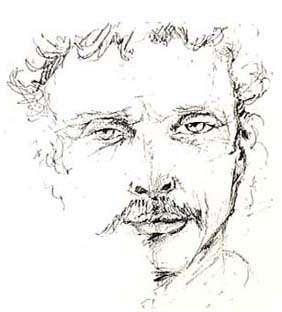Born in 1946, Jean-Paul Montange attended the Ateliers du Louvre. His interest is in Traditional Art and Sacred Art.
For more than 30 years, through journeys and meetings, Jean-Paul Montange has been researching relationships between shapes, color and energy.
Painter of figurative to abstract, he plays with a deep subtlety on nuances and values. The intense radiance of its yellows and reds opens the space, its blues and grays become transparent, its bronzes and golds create a powerful effect of matter.
From the luminosity of its colors, from the spontaneous balance of the composition, from its lively and rigorous outline, there emerges an energy inviting to re-emerge through the work.
Painter of cosmic movements, Jean-Paul Montange brings us to the original serenity.
Nathalie Weinryb, Arts Program

The work of Jean-Paul Montange is in the current of modern painting by the abstraction of his lyricism. But, it is more before it is necessary to look for its roots, in the line of those painters in whom the imaginary serves to break like a shell the appearance of the newspaper to allow him to reveal itself as it is essentially: a fantastic and overwhelming miracle; also to look for the same filiation of painters for whom the breakthrough of the dream is nothing more than an advance towards a more authentic and almost objective reality.
These painters, such as Jérôme Bosch, William Turner, William Blake and Salvador Dali, have traced the history of painting since the Renaissance. They transcribed on their canvases all the inanity of the world by the tragic drawing of our simple existences, hallucinations as unreal as a dream and as evanescent as a sunrise. Jean-Paul Montange plunges directly, corporally into the whirlwind of energies that preside over our universe, to make us feel that any attempt to fix the forms is only the illusory desire for mental comfort.
The energies, he captures them, browses them, retraces them with his hands with only guide in this journey through the forms, a right rhythm of the gesture, which is at the end of the arm that the apparent course of internal currents that the go through and cross it. That’s why his painting touches us first of all by his power to shake up our body schemas, his body at the moment of the work, having to be impeccably and relentlessly present in his least fibers. Then we become sensitive to the irruptions of color, to the foci of the yellows, as to the magnificence of the golds: here we come to something which, in Modern Art, no longer bears any name, and which was named the Beautiful.
By the particular acrylics he uses, the painter arrives at a transparency of the pictorial material difficult to reach by the techniques of contemporary oil painting. The light accumulated by the passage, layer after layer, buffers and scrapings, is returned to the surface thanks to a special preparation of the canvas whose grain always very fine avoids easy effects of refraction. Blue, the color symbol of virginity, thus reaches at times such a translucency that the canvas evokes the art of stained glass.
His method of execution which requires a total implication of corporality could have some similarity with that of Action Painting, and particularly with that of his illustrious representative Jackson Pollock, in the United States. But the intensity of the light as much as the density of the color leave no doubt on the path of the painter: more than a gestural, the work is born of an adherence to the cosmic vibration, whose formal footprint essentially Spiroidal strengthens us and reveals our vital energies.
Jean-Paul Montange tends towards this ultimate transparency where without emotivity but in pure emotion, the world appears and, in the same instant, disappears. It is up to us, in front of the canvas, to marry this fluidity that gives body to space and leads us, beyond the impermanence of forms, to this unique point from which everything emerges.
Christian Gilloux, Writer.
